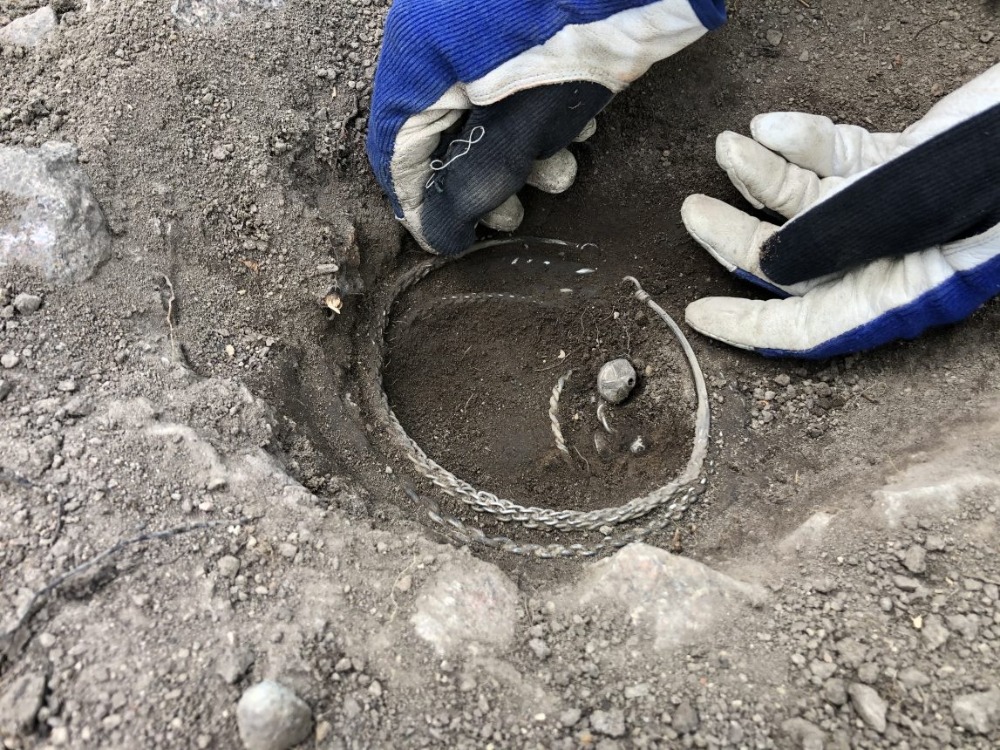Je to nádhera a ve stříbře. Prostě boží 
Archaeologists discover rare Viking treasure with the help of a metal detector
Categories: Treasures , Finds and rescue research abroad , Nálezy nejenom s detektorem ve Skandinávii
In 2019, evidence of a 1,500-year-old farm and a later settlement from the early to high Middle Ages was discovered in Viggbyholm, Sweden. Recently, in one of the younger houses, archaeologists found a rare hoard of Viking silver jewellery and coins, which they said "The
8 000 m2 site is located in a wide coastal bay near Stockholm. For the past two years, intensive rescue archaeological research has been carried out here in preparation for new urban development. There was a settlement here in the Iron Age, which persisted into the Middle Ages. Earlier this year, archaeologists excavated the foundations of more than twenty so-called "long houses" built in the late Iron Age and early Middle Ages. The oldest dates from 400 AD, while the youngest date back to the Viking Age. The head of the work, Magnus Lindberg, told the Swedish press that inside one of the younger houses, a metal detector discovered a treasure jar "the kind of treasure that only comes along once in a lifetime".
A ceramic pot with a linen sleeve was found under the former wooden floor, which contained a set of Viking silverof Viking jewellery in excellent condition and quality - especially ornately twisted bracelets and necklaces. There were also silver coins from several different countries - Central Europe, France, Germany and England, as well as five Arabic silver coins - dirhams. One of the European silver coins dates from the 10th century and was minted in Rouen, France. According to Professor Jens Christian Moesgaard of Stockholm University, this is a very rare coin, with only two known examples to date.
"When I started to carefully extract the artefacts one by one, I had such an extraordinary feeling, especially when the others just kept coming again and again. In total, there were eight high-quality bracelets and necklaces in exceptionally good preservation, even though they were made and stored almost a thousand years ago. They looked almost brand new," archaeologist Maria Lingström described the circumstances of the find.
According to the experts, similarly composed silver treasures inside a residential building are very unusual. This significantly increases the rarity of the find. They also believe that there is a "classical interpretation" of the circumstances of the treasure's deposition - i.e. that people hid their valuables hastily in times of hardship - is uncertain to say the least. In this case, according to Dr. Lindberg, the treasure was most likely deposited in the 11th century, but there are "telling signs that the treasure was later removed and subsequently re-deposited."
During the Viking period, Nordic warriors, traders and diplomats travelled throughout Europe. However, the vast majority of the population were farmers who could only dream of similar artefacts. Silver was the "real currency" and goods were paid for with silver, especially fractions of silver. In a trade deal, the required amount of silver was simply cut off the bar. However, this new discovery represents beautifully crafted Viking silver jewellery. Many other similar Viking finds were more votive in nature.
Evidence of Vikingers activities abroad is largely supported by the discovery of silver treasures from distant areas. It is questionable why foreign coins were found on an ancient Swedish farm. Perhaps some stranger paid the farmers for their goods in silver. But it could also be that some of Viggbyholm's men threw down their hoes to pick up swords and head abroad on summer raiding missions.
Roman Nemec
 Cleaning and conservation
Cleaning and conservation Silver treasure in Viggbyholm
Silver treasure in Viggbyholm
 Maria Lingström excavating one of the houses
Maria Lingström excavating one of the houses

A unique treasure from the Viking Age

Sources: arkeologerna.com, thevikingagearchive.com
The article is included in categories:











